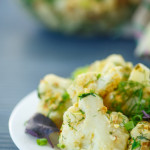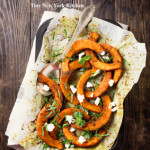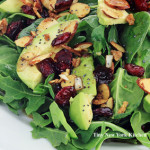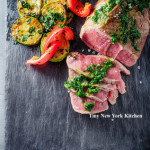Most vegan foods are quite obvious, but it’s important to check the label for ingredients like egg whites, gelatin, honey, or milk.
When in doubt at a restaurant, ask your server to confirm your order is vegan. Dishes are often enriched with non-vegan ingredients like chicken stock or fish sauce.
Rather than focus on what you can’t eat, celebrate what you can. Vegans can enjoy a wide range of foods, including all fruits and vegetables, beans and other legumes, pasta and grains, soy-based foods like tofu and tempeh, and herbs and spices.
“Work With What You Got!”
©Tiny New York Kitchen © 2019 All Rights Reserved
To flavor your food reach for herbs and spices rather than high-sodium table salt. Make sure to read the labels of seasoning mixes because many of them contain salt.
Seasoning Suggestions
Pasta: Basil, Fennel, Garlic, Paprika, Parsley, Sage
Potatoes: Chives, Garlic, Paprika, Parsley, Rosemary
Rice: Cumin, Marjoram, Parsley, Saffron, Tarragon, Thyme, Turmeric
Seafood: Chervil, Dill, Fennel, Tarragon, Parsley
Vegetables: Basil, Caraway, Chives, Dill, Marjoram, Mint, Nutmeg, Oregano, Paprika, Rosemary, Savory, Tarragon, Thyme
“Work With What You Got!”
©Tiny New York Kitchen © 2019 All Rights Reserved
This Year Tiny New York Kitchen Is Focusing On How To Get More Vegetables Worked Into A Regular Diet.
Ease Into The New Year With Delicious Salads
“Work With What You Got!”
©Tiny New York Kitchen © 2019 All Rights Reserved
Noel has been in English since the 13th century as a forename and family name (e.g., Nuwel, Nuuel) for those born or baptized on Christmas or during the Christmas season. In the late 14th century, Nowel is used as an exclamation of joy in The Canterbury Tales (this usage remains only in Christmas carols). In the late 14th century alliterative poem Sir Gawain and the Green knight, Nowel meant “Christmas day, the feast of Christmas, Christmastide.” Middle English shows several spellings, e.g., Newel, Nouel, Nowelle, Nowel, all derived from Anglo-French, Middle French, and Old French forms (Nowel, Nowelle, Nouel, Noel), Noel in French. The spellings with 0 (e.g., Noel) are a variant of spellings with a (e.g., Nael) that began in the 12th century. Nael is a regular French development from Latin natalis (in full, dies natalis “birthday”).
“Work With What You Got!”
©Tiny New York Kitchen © 2018 All Rights Reserved
We at Tiny New York Kitchen get it! Especially during the holidays you don’t want to ruin a good piece of meat. Here are some general guidelines for producing the best results for your holiday meal.
Remove meat from the refrigerator at least an hour before roasting so it can come closer to room temperature.
Start the roast at 450 degrees for 15 minutes to develop a nice crust.
Drop the oven to 350 degrees for an additional 15 to 20 minutes per pound.
Remember, you must cook to temperature, NOT time, because every oven and piece of meat is unique. So, take the temperature of the roast every 20 to 30 minutes to avoid overcooking. 120 degrees (50C) for rare and 130 degrees (55C) for medium-rare.
Always use a meat thermometer. An instant-read probe thermometer helps dispel any guesswork.
Remove from oven and loosely cover roast with foil to keep warm and rest it for 30 minutes. Don’t be alarmed when you see the temperature of the roast creep upwards a few degrees while it rests. This is perfectly normal and expected.
These directions will work for nearly all holiday roasts. The exceptions are thinner/smaller roasts like beef tenderloin or rack of lamb. These can be cooked at 400 degrees for the entire time, using a meat thermometer to monitor progress.
“Work With What You Got!”
©Tiny New York Kitchen © 2018 All Rights Reserved
Fruitcake Pound Cake Is A Delicious And Easy Holiday Favorite
Now that the colder weather is here and you’ve put away your beach towel it’s time to winterize your cocktails. One way to achieve this is by using amari, the rich, bitter, herbal European-style liqueurs-before–dinner aperitifs and after-dinner digestifs-that have become more popular and widely available. Amari can add structure and backbone to cocktails and is often the secret behind some of the most iconic classic drinks. Amaro is perfect for colder months, to pair with flavors like honey, citrus, and spices. Adding it is like seasoning food because it enhances flavors and gives the drink more character.
This season bartenders are combining them with brown spirits like dark rum, bourbon, rye, and Scotch for autumn and winter drinks. You could make a variation on the Brooklyn cocktail with bourbon, amaro, maraschino liqueur, dry vermouth, blood orange liqueur, and bitters.
Some add amaro and bourbon to mulled wine or change up that Irish Coffee by using single-malt whiskey, two kinds of amaro, coffee, simple syrup, and topped with whipped cream. Change up the Negroni by keeping the gin, but replacing the Campari with amari and adding amontillado sherry.
Be inventive and try adding amari to your holiday cocktails. You may just create a new classic.
“Work With What You Got!”
©Tiny New York Kitchen © 2018 All Rights Reserved















